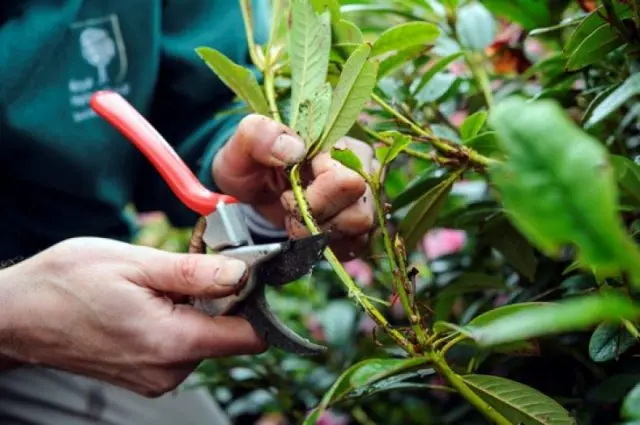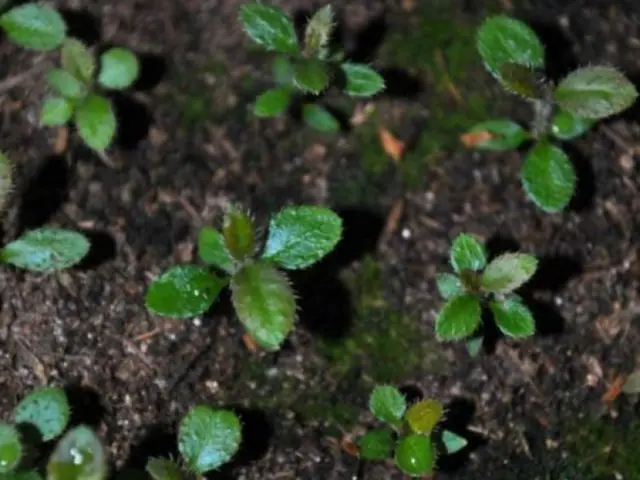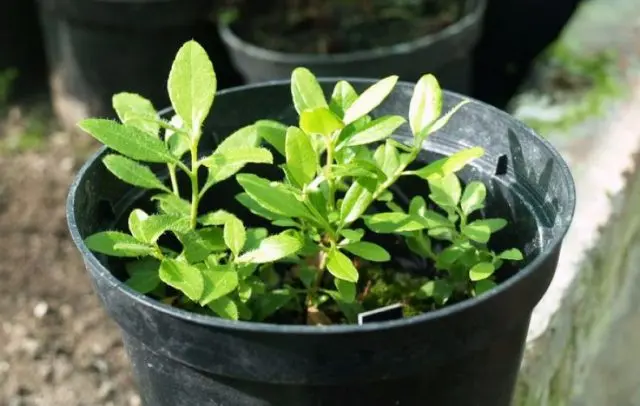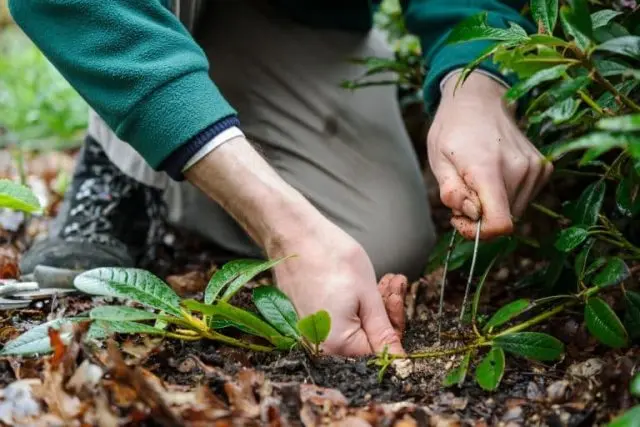Contents
Rhododendron can be propagated not only with the help of ready-made seedlings purchased in a special nursery. If there is at least one shrub of this species on the site, you can use proven methods of breeding ornamental crops and expand your collection of rhododendrons.

How to breed rhododendrons
Rhododendron is a very beautiful ornamental culture, which is unpretentious to growing conditions. The visual appeal of the rhododendron and its botanical characteristics make the plant quite expensive. If you want to plant several shrubs at once on your site, you will have to spend a lot of money on the purchase of seedlings. However, it is possible to avoid unnecessary expenses and use planting material taken from existing plants.
You can save on the reproduction of rhododendron by resorting to self-breeding of the plant. There are the following ways to propagate rhododendron at home:
- cuttings;
- growing from seed;
- reproduction by layering;
- division of the bush.
It should be noted that home breeding of rhododendron is a rather slow process, and this is its main drawback. A ready-made seedling allows you to enjoy the decorative appearance of the plant the very next year, while with independent reproduction, the shrub will come into full force only after a few years. But growing shrubs on your own is very interesting, quite simple and allows you to do without costs. That is why rhododendron propagation methods are popular with gardeners.
How to propagate rhododendron cuttings
The most common way to propagate a shrub is cuttings, or growing a single plant from a small shoot taken from an existing shrub. The advantages of cuttings include not only the simplicity of the process, but also the speed of reproduction of the rhododendron – in some cases, after 1-2 years, the shrub can begin beautiful flowering for the first time.
The first stage of cuttings is the preparation of material for propagation. It is carried out according to the following rules:
- from the end of May to mid-June, shoots are cut on an adult bush – it is necessary to cut rhododendron with young annual shoots that are already half lignified;
- the length of the cuttings is left from 7 to 15 cm, while on each blank several leaves are left at the top, and the leaves at the bottom are removed;
- the lower part of the shoot is cut off with a sharp clean blade at an angle of 45 °, the cut should not be straight, but oblique.
After the cuttings for rhododendron propagation are prepared, they will need to be put in water for a day with the addition of a growth stimulator. Subject to the rules of reproduction, it is possible to root a rhododendron without a stimulant, but the process can take a long time.
While the rhododendron is being propagated by cuttings in water with a stimulant added to it, it is necessary to prepare nutrient soil and pour it into a small container. The soil for the cutting should meet the usual requirements of an adult shrub. Since the rhododendron prefers soil with a high level of acidity, it is customary to prepare mixtures of peat, sand and coniferous earth, taken in equal proportions, for cuttings.

The further process looks like this:
- the prepared soil is placed in small containers, lightly tamped and leveled;
- cuttings under a slight slope of 30 ° with a slight depth are installed in the substrate;
- the soil around the shoots is lightly pressed and watered abundantly;
- the container is covered with plastic wrap and the cutting is placed in a room with a temperature of about 25 ° C and with good lighting.
For quick rooting, rhododendron cuttings require not only high temperature, but also high humidity – just for this purpose, the containers are covered with a film. But since the cuttings need access to oxygen, from time to time the film needs to be lifted so that the plant can breathe.
In home-made miniature “greenhouses”, the cuttings remain for 2-3 months, which is exactly the time they need on average for rooting. Growing a rhododendron from a cutting is not difficult, the plant reproduces very well – subject to the rules of reproduction, the shoots are almost guaranteed to give strong roots.
- Since the rooting of cuttings planted in early or mid-summer occurs closer to autumn, the first wintering of young plants takes place at home.
- Strengthened cuttings are transplanted into new, more spacious containers, trying to keep the old substrate around their roots. Fresh soil should also be acidic, consisting mainly of peat with the addition of pine needles.
- Transplanted cuttings are regularly watered, carefully monitoring the level of soil moisture.
- A couple of weeks after transplanting, plants can be fed with nitrogen fertilizers for the first time – this will ensure faster and more successful growth.
During the winter, young rhododendrons must be kept in a bright but cool room, it is best if the temperature does not rise above 12-15 ° C.
It is possible to plant cuttings in open ground already in the spring, to a temporary place where the plants can finally get stronger. You can also leave young rhododendrons at home for 1-2 years and simply transfer them to larger containers. In the latter case, after 1-2 years, the plants can be immediately planted on a permanent site.
Reproduction of rhododendrons by seeds
Reproduction, planting and caring for rhododendrons is also carried out using the seed method – seeds can be purchased at the store or collected independently from adult rhododendrons in your area. Shrub seeds fully ripen in late autumn, when the box becomes brown-greenish, and the seeds inside it turn brown. At this time, in dry weather, it is necessary to collect.
Seeds are sown not immediately after harvest, but in February or early March. For sprouts, you need to pick up containers with drainage holes at the bottom and fill them with a standard soil mixture for rhododendrons – a soil consisting of peat, sand and pine needles. Before planting seeds, the soil must be disinfected – seeds are especially susceptible to any infections.

When planting seeds, you need to adhere to the following algorithm:
- soil is poured into prepared containers, but they are not tamped down and not watered;
- seeds are scattered on the ground, since part of the planting material may not germinate, it is more practical to initially take fairly wide containers and place several seedlings in them at once;
- gaps of about 1,5 cm are left between individual seeds – this will avoid subsequent thinning of seedlings;
- seedlings are carefully watered with water, without falling asleep on top of the soil, and then covered with a film to create greenhouse conditions.
The first stage of propagation of rhododendron seeds is the simplest. After sowing, the seed container should be placed in a warm, bright room with a temperature of about 25 ° C. The soil needs to be moistened as needed, and the film should also be periodically removed from the container to ensure oxygen access.
The first shoots can appear in just 2-3 weeks, and the film can be removed from the containers. But it is at this stage that difficulties will arise in the cultivation of rhododendron.
- Sprouts obtained from seeds are highly sensitive to temperatures. It is impossible to leave seedlings warm, they will grow too weak and quickly die at the slightest stress. It is best to put the container with sprouts in a cool room with a temperature not higher than 12-15 ° C.
- Rhododendrons propagated by seed are demanding on the irrigation regime. Drying out of the soil leads to almost instantaneous death of seedlings, but sprouts also react badly to waterlogging. It is necessary to constantly control the level of soil moisture, and it is better to supply the sprouts with moisture as before through the pan – this reduces the risk of moisture stagnation in the soil.
- When the seedlings get a little stronger, once a day they will need to be taken out for a while to fresh air. The process is a hardening of plants, rhododendrons from seeds must get used to street conditions in advance.
With the onset of June, seedlings can be transferred to larger containers and slightly increase the distance between individual shoots. With the establishment of warm weather, young rhododendrons can be taken out into the garden and left in the fresh air until autumn – this will strengthen the plants and make them more viable. You need to put the container in a lighted place, but protection from direct sunlight should be provided.
In the autumn of the first year, rhododendron seedlings are brought back into the house in a cool room with a temperature below 18 ° C. It is still impossible to leave the plant on the street, the seedlings are still too weak and vulnerable. During the winter, they are carefully watered, it will also be useful to organize artificial lighting for seedlings so that the daylight hours for rhododendron are at least 16 hours.

With the onset of spring in early March, young plants will need to be planted again and again increase the distance between the shoots. A couple of weeks after this, the rhododendron can be fed with nitrogen fertilizers for the first time for active growth. For the second summer, the plant is again taken out into the garden and left until autumn, and with the onset of a cold snap, they are returned to the room.
Thus, the planting of rhododendron from seeds in open ground is carried out only on the third spring after reproduction – in a temporary place. For another 1-2 years, the shrub should be strengthened in outdoor conditions, and only then it can be transferred to a prepared permanent site.
Reproduction of rhododendron by seeds is considered quite difficult, since young shoots very often die at the slightest change in temperature or during irrigation failures. The disadvantages of this method of reproduction include the fact that it will be possible to plant plants in the ground at the final place only after a few years, and the rhododendron will begin to bloom at all in 6-10 years.
How to propagate rhododendron cuttings
Another popular method involves the cultivation of shrubs in outdoor conditions – the propagation of rhododendron by layering. Rooting in this case occurs directly in the ground, and already in the first year, the layers hibernate in the open. It is necessary to carry out the breeding procedure in the spring, if you postpone it to a later date, then the shoots will not have time to take root and will die.
The breeding procedure is as follows:
- an adult rhododendron is carefully examined and several long shoots are selected, located as close to the ground as possible;
- the shoots are bent to the ground and in the place where they come into contact with the soil surface, a small cut is made along the wood, slightly splitting the stems;
- small chips can be placed in the places of cuts – this will contribute to rapid rooting and prevent the cuts from closing;
- small indentations are made in the ground about 15 cm deep, incised shoots are placed in the holes and fixed with a wire or a staple;
- from above, the layers are covered with soil suitable for rhododendron and mulched with a layer of peat.
The upper part of the shoot should remain above the ground. During the summer, layering is regularly watered.
As a rule, by the fall, the layers take root quite well. However, they must survive the first winter, being still associated with the mother bush, if the transplant is carried out in the fall, the plant will not have time to adapt to the new place and will die.
Before the onset of cold weather, layering is covered with spruce branches and dry leaves. In the spring, the shelter is removed and young plants are carefully dug out of the ground, after which they are separated from the main bush. An earthen ball formed around the roots is better to save and transplant the rhododendron with it, so as not to damage the young shrub. Immediately after planting in a permanent place, the rhododendron is watered, mulched and carefully monitored throughout the season until the plant is fully adapted.

How street rhododendron reproduces by dividing the bush
Reproduction by dividing the bush is a reliable, but not the most popular agrotechnical method. Despite the fact that it is quite simple to breed a rhododendron in this way, very few new plants can be brought out from the mother bush, and besides, the bush itself receives quite serious damage.
Reproduction by dividing the bush occurs as follows:
- an adult, healthy, well-grown rhododendron is chosen on the site, the decorative effect of which will not suffer from the division procedure;
- in spring, with a sharp shovel, the uterine bush is cut into several separate parts, each of them must have strong intact roots and healthy shoots;
- small roots near the base of the bush are removed with a knife, the separated bush is planted in acidic prepared soil in a specially created greenhouse, or, in the case of a small bush, in a spacious container.
Further care for the separated bush is carried out according to the standard scheme – in the first year of life, the rhododendron needs regular watering, mineral supplements and protection from direct sunlight. For the winter, the rhododendron still remains in the greenhouse, although the temperature in it drops significantly.
A year after separation from the main bush, new shoots appear in the plant, and at the beginning of summer the rhododendron is transplanted to a permanent place in open ground, where it continues its formation.
Tips from experienced gardeners
Reproduction of rhododendrons can be carried out in many ways. In addition to the existing algorithms for planting seeds, cuttings and layering, there are also some nuances of growing shrubs that experienced gardeners know about.
- Which method of propagation of rhododendron to choose depends on its individual characteristics and the variety of shrubs. Seed propagation is most often used to increase the population of wild rhododendrons. For varietal ornamental species, it is better to choose planting rhododendron with cuttings or use layering, so the plants are more likely to successfully take root and retain all the characteristics of the main bush.
- For any reproduction, it is necessary to take planting material only from strong and healthy plants. Sick and weakened rhododendrons will give the same weak and prone to fading offspring.
- When propagating rhododendron by cuttings at home, a plant in the second year of life can begin to form buds – even before planting in the ground. At this point, it is best to cut off the buds and pinch the tops of the shoots of the plant, the fact is that early flowering is detrimental to the growth of the vegetative mass. In the first years of a plant’s life, care should be taken mainly that it releases more strong roots and grows shoots.
- Cuttings of evergreen rhododendrons, as well as propagation by layering or seeds, is a more complex process than breeding deciduous rhododendrons. Shrubs that drop foliage for the winter are more unpretentious and, in general, are much more likely to be bred at home.
In general, for beginner gardeners, the cultivation of rhododendrons is most recommended by cuttings or layering. Both of these methods of reproduction are very simple, while seed breeding or dividing a bush requires more experience and knowledge, and also has significant drawbacks.

Conclusion
You can propagate rhododendron without spending too much on ready-made seedlings – home breeding methods allow you to independently increase the number of beautiful and elegant shrubs. However, when propagating rhododendrons at home, you need to prepare for the fact that the process will not be fast, and the plant will reach its maximum decorativeness only after a few years.









